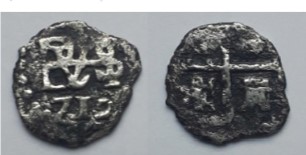Written by the TreasureGuide for the exclusive use of the Treasure Beaches Report.
 |
| Half Reale.1. |
Let's play a game - Name the Reign. On second thought that is too easy? Where were these coins minted?
 |
| Half Reale 2. |
 |
| Half Reale 3. |
All the half-reale varieties described in this paper, and those shown above, were minted in Lima between 1684 and 1752. The first three shown above are of a date that puts them in the range of dates possible for 1715 Fleet cobs.
You may have found some with the familiar Charles and Phillip monograms.
It seems using the e on the end of real as become common. That is a convention I started using almost twenty years ago, and since then it seems to have caught on.
---
Enlisted dogs of World War II.
These first steps were undertaken by Lt. Col. Clifford C. Smith, chief of the Plant Protection branch, Quartermaster Corps, who was responsible for the security of not only military installations across the United States but also the factories that produce the materials needed for an all-out war effort. It was strongly urged that the use of sentry dogs would be advantageous against any sabotage operations.
A major change took place on July 16, 1942, when Secretary of War, Harold Stimpson, directed the quartermaster general to train dogs for other functions besides sentry duties. These abilities would include scout and patrol, messenger, and mine detection. Unofficially the Quartermaster Corps termed the war dog program, the “K-9 Corps.” The program would be expanded even further, providing dogs for both the Navy and Coast Guard. It should be noted that the Coast Guard maintained the largest contingent of war dogs, more that 1,800, for patrols along the east and west coastlines of the United States during World War II...
Here is the link to a lengthy article.
WW2 Volunteer Effort | US War Dogs
---
 |
| Source: nhc.noaa.gov |
There is a little activity on the map now, but it looks like the one will stay far out to see and it will be a while before the other one develops, if it ever does.
The surf will remain small for a week or so. The high tides are becoming less high.
Good hunting,
Treasureguide@comcast.net





